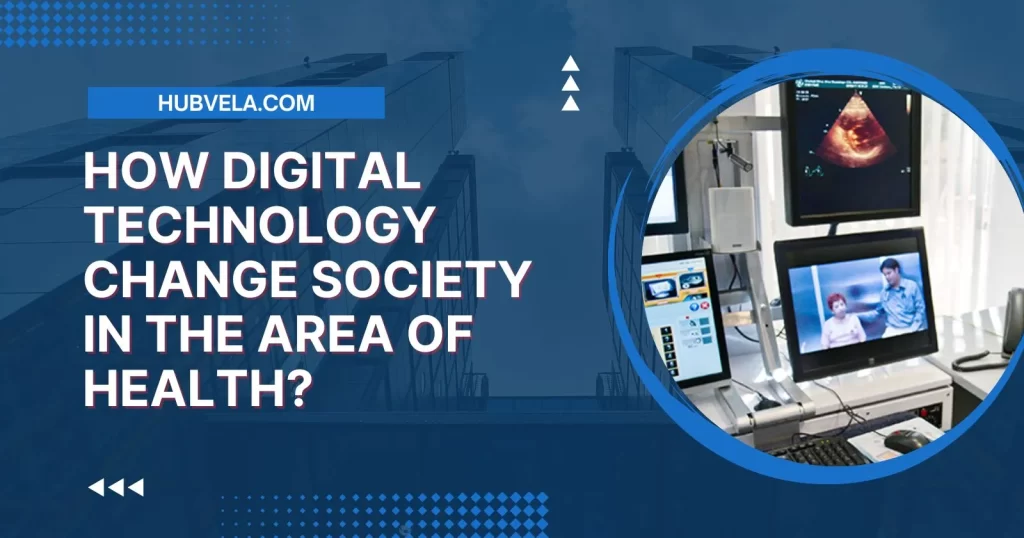Digital technology has revolutionized many aspects of our lives, including healthcare. The use of digital technology in healthcare has greatly improved patient care and medical practices.
With the advent of digital technology, patients now have improved access to medical information and data, which has been one of the biggest benefits of the digital revolution.
Digital technology has also enhanced patient medical records, leading to improved patient and provider satisfaction.
Medical care standards have been greatly improved by digital technology, which provides treatment opportunities, knowledge, and learning opportunities. In this article, we will explore How Digital Technology Change Society in the Area of Health.

--Advertisement--
How Digital Technology Change Society in the Area of Health (Infographics)

Telemedicine and Remote Patient Care (Expanding Access to Healthcare)
Telemedicine and remote patient care are innovative healthcare delivery models that use digital technology to provide medical care to patients remotely.
These models have been made possible by advances in digital technology and have the potential to revolutionize healthcare delivery by expanding access to care and improving patient outcomes.
Here are some ways in which telemedicine and remote patient care are changing society in the area of health:
Increased access to care: Telemedicine and remote patient care can help overcome barriers to healthcare access, such as distance, transportation, and mobility issues. Patients who live in rural or remote areas can receive medical care from specialists located in urban areas without having to travel long distances. This can be especially important for patients with chronic conditions who require frequent monitoring and follow-up care.
Improved patient outcomes: Telemedicine and remote patient care can improve patient outcomes by providing timely medical care and reducing hospital readmissions. Remote patient monitoring, for example, allows healthcare providers to monitor patients’ chronic conditions and manage acute conditions from their own homes, which can reduce the risk of infection and cut down on travel costs.
Cost savings: Telemedicine and remote patient care can reduce healthcare costs by reducing the need for hospital visits and readmissions. Patients can receive medical care from the comfort of their own homes, which can reduce the need for expensive hospital stays.
Advancements in technology: Telemedicine and remote patient care are constantly evolving with the continued advancement in available technology. Modern systems can be equipped with the ability to acquire and summarize data in order to inform the patient, carer, or healthcare giver. Artificial intelligence and data analytics are also being used to improve patient outcomes and reduce healthcare costs.
Telemedicine and remote patient care are innovative healthcare delivery models that have the potential to revolutionize healthcare delivery by expanding access to care, improving patient outcomes, and reducing healthcare costs.
As technology continues to advance, these models will likely become even more sophisticated and effective in improving healthcare delivery.
Wearable Health Devices and Personalized Monitoring
Wearable health devices are electronic devices that consumers can wear, such as Fitbits and smartwatches, and are designed to collect data on users’ personal health and exercise.
The use of wearable technology has increased in the last few years, in accordance with consumers’ increased interest in monitoring their own health and vital signs.
Wearable devices in healthcare can be used to perceive, record, analyze, regulate, and intervene to maintain health and can even be used to treat diseases with the support of various technologies for identification, sensing, connection, cloud services, and storage.
The development of wearable sensors in the healthcare market has been relatively slow, despite wearable devices having emerged as a major part of lifestyle and fitness markets.
However, the advancement of wearable sensor technology provides enormous opportunities for deployment in health care, especially in connected health care and precision medicine, in which wearable devices can achieve high-quality, real-time measurements of personal health.
The use of wearable health technology has generated a booming market, and now insurers and companies are seeing how supplying wearable health technology to their consumers and employees is beneficial.
Wearable fitness technology has carved out such a significant space for itself in the healthcare industry that devices such as FitBits and smartwatches are now viewed as mainstream.
Clinicians should establish a connection between their electronic health records (EHRs) and patients’ wearable devices to record their health progress.
The interface between EHR and wearables is important for the successful implementation of wearable health devices in healthcare.
However, there are challenges and recommendations for wearable devices in digital health. One of the main areas of use of wearable devices is health, including biomedical research, clinical care, personal health practices, and tracking.
The extent to which individual users can access the benefits of this data collection seems unequally distributed.
Users with more digital literacy and socioeconomic resources are disproportionately advantaged to access benefits from the use of wearables as tools to detect and predict states of health and disease.
Successful implementation of wearable technologies in the clinical arena can produce measurable benefits, which accrue to patients and the health system.
The development of personalization strategies in digital health technologies amplifies the impact of digital tools and is an area ripe for innovation in order to reduce the human burden in future applications.
The Consumer Technology Association (CTA) and Heart Rhythm Society (HRS) have released a unique digital health paper recommending best practices for managing personal health with wearables.
Electronic Health Records (Streamlining Patient Data Management)
Electronic Health Records (EHRs) are digital versions of a patient’s paper chart that contain the medical and treatment histories of patients. EHRs are real-time, patient-centered records that make information available instantly and securely to authorized users.
EHRs are built to share information with other healthcare providers and organizations, such as laboratories, specialists, medical imaging facilities, pharmacies, emergency facilities, and school and workplace clinics, so they contain information from all clinicians involved in a patient’s care.
EHRs help providers better manage care for patients and provide better health care by providing accurate, up-to-date, and complete information about patients at the point of care, enabling quick access to patient records for more coordinated, efficient care.
The advantages of EHRs include improving all aspects of patient care, including safety, effectiveness, patient-centeredness, communication, education, timeliness, efficiency, and equity.
EHRs and the ability to exchange health information electronically can help provide higher quality and safer care for patients while creating tangible enhancements for healthcare organizations. EHRs are the first step to transforming health care.
Digital health is a broad, multidisciplinary concept that includes concepts from an intersection between technology and healthcare. Digital health applies digital transformation to the healthcare field, incorporating software, hardware, and services.
Under its umbrella, digital health includes mobile health (mHealth) apps, EHRs, electronic medical records (EMRs), wearable devices, telehealth, and telemedicine, as well as personalized medicine.
The application of information and communications technology to provide digital health interventions to prevent disease and improve quality of life is not a new concept.
However, in the face of global concerns related to aging, child illness and mortality, epidemics and pandemics, high costs, and the effects of poverty and racial discrimination on access to healthcare, digital health platforms, health systems, and related technology continue to grow in importance and to evolve.
EHRs are a vital part of health IT and can help streamline patient data management. They provide accurate, up-to-date, and complete information about patients at the point of care, enabling quick access to patient records for more coordinated, efficient care.
EHRs are built to share information with other healthcare providers and organizations, making them inclusive of a broader view of a patient’s care.
Digital technology is changing society in the area of health, and digital health platforms, health systems, and related technology continue to grow in importance and evolve.
Virtual Reality and Augmented Reality in Medical Training and Treatment
Virtual Reality (VR) and Augmented Reality (AR) are transforming the healthcare industry by enhancing medical training and treatment. Here are some ways in which digital technology is changing society in the area of health:
Medical Training:
- VR medical training is a simulated experience that only occurs in the virtual world. Healthcare students use virtual headsets to learn and practice procedures in a safe and controlled environment.
- AR/VR can deliver some types of clinical services, including some normally delivered only in clinics and hospitals, to patients in their homes or other non-clinical settings. This could enable patients, including the socioeconomically vulnerable and underserved, to receive care more easily and conveniently.
- The Johns Hopkins School of Nursing has implemented VR training at all levels, from doctoral to prelicensure nursing. Areas of focus for training include resuscitation, anaphylactic reactions, postsurgical management, acute-care management, and pediatric critical care.
Medical Treatment:
- VR rehabilitation therapy simulates real-life situations to improve physical functions for patients who have experienced a physical disability associated with a stroke or other medical condition.
- AR/VR can be used for diagnostics and treatment, such as in the case of Touch Surgery, where a student or intern can conduct virtual surgery without potentially harming a patient. This technology also allows medical schools to avoid cadavers during practical training, which helps avoid the moral and ethical issues involved in this training process.
- AR/VR provides limitless possibilities for the healthcare industry. Researchers and companies are coming up with different solutions and ideas for using these technologies to improve patient care.
VR and AR are revolutionizing medical training and treatment. They provide a safe and controlled environment for healthcare students to learn and practice procedures, and they offer new types of treatments and diagnostics that can improve patient care.
As technology continues to advance, we can expect to see even more innovative uses of VR and AR in the healthcare industry.
Ethical and Privacy Considerations in Digital Health
Ethical and privacy considerations in digital health are of utmost importance as digital technology continues to transform the healthcare landscape. Here are some key points to consider:
Privacy Protection:
The use of digital health technologies, such as wearable devices and health apps, involves the collection and storage of personal health data. It is crucial to ensure that individuals’ privacy is protected and that their data is handled securely Unauthorized access or misuse of personal health data can lead to ethical concerns and breaches of privacy.
Strong regulations and safeguards should be in place to protect individuals’ privacy rights.
Informed Consent:
In the context of digital health, obtaining informed consent from individuals is essential. Users should have a clear understanding of how their data will be collected, used, and shared.
Transparent communication about data practices and giving individuals control over their data can help build trust and ensure the ethical use of digital health technologies.
Equity and Non-Discrimination:
Digital health technologies should be leveraged to advance the right to health in an equitable and nondiscriminatory manner.
It is important to ensure that these technologies are accessible to all individuals, regardless of their socioeconomic status, race, or other factors. Ethical considerations should be taken into account to prevent exacerbating existing health disparities.
Data Accuracy and Reliability:
Digital health technologies, including artificial intelligence and machine learning algorithms, have the potential to support healthcare decision-making.
However, it is crucial to ensure that these technologies are rigorously tested and validated. Ethical considerations include the need for transparency in algorithm development, accountability for algorithmic biases, and ongoing monitoring of the technology’s performance.
Confidentiality and Security:
Maintaining the confidentiality and security of health data is paramount in digital health. Robust measures should be in place to protect data from unauthorized access, breaches, and cyber threats. This includes implementing encryption, secure data storage, and regular security audits.
Ethical Research Practices:
Digital health research should adhere to ethical principles and guidelines. This includes obtaining informed consent from research participants, ensuring privacy and confidentiality, and conducting research with integrity.
Ethical considerations should be taken into account when conducting research in conflict or humanitarian settings, where vulnerable populations may be involved.
As digital technology continues to shape the healthcare landscape, it is crucial to prioritize ethical and privacy considerations.
Protecting individuals’ privacy, ensuring informed consent, promoting equity, and maintaining data accuracy and security are essential for the responsible and ethical use of digital health technologies.
Brain Health Consequences of Digital Technology Use
Digital technology use can have both negative and positive effects on brain health, according to emerging scientific evidence. Here are some of the potential negative consequences of extensive screen time and technology use:
- Reduced attention
- Impaired emotional and social intelligence
- Technology addiction
- Social isolation
- Impaired brain developmentDisrupted sleep
- Structural changes in the brain
However, it’s worth noting that various apps, video games, and other online tools may benefit brain health. Additional research is needed to fully understand the positive and negative effects of technology on the brain.
To better manage the impact of technology on brain health, it’s recommended to implement periods of intentionally limited technology use. This can help individuals regain healthier habits and reduce the negative consequences of excessive digital technology use.
Physical and Psychological Well-Being in a Digital Technology World
In today’s digital technology world, both physical and psychological well-being can be influenced by our interactions with digital devices and platforms. Here are some key points to consider:
Physical Well-being:
Digital Wellness: Digital wellness refers to the use of technology to promote and maintain physical health. It involves designing technology in a way that encourages healthy use and supports a healthy lifestyle. For example, using fitness tracking apps or wearable devices to monitor physical activity and encourage exercise.
Healthy Use of Technology: Excessive use of digital devices, such as smartphones or computers, can have negative effects on physical well-being. It can lead to sedentary behavior, eye strain, poor posture, and disrupted sleep patterns. Practicing mindful and balanced use of technology can help mitigate these risks.
Ergonomics: Paying attention to ergonomics while using digital devices is important for physical well-being. This includes maintaining proper posture, using ergonomic furniture and accessories, and taking regular breaks to stretch and move around.
Psychological Well-being:
Digital Well-being: Digital well-being also encompasses mental health and emotional well-being. It involves using technology in a way that supports mental well-being and reduces stress and anxiety. For example, using meditation or mindfulness apps to manage stress.
Impact on Mental Health: Research has shown that excessive use of digital technology, particularly social media, can contribute to feelings of loneliness, depression, and anxiety. It is important to be mindful of our digital consumption and take breaks when needed.
Digital Detox: Taking regular breaks from digital devices and engaging in offline activities can help improve psychological well-being. This can include spending time in nature, pursuing hobbies, or engaging in face-to-face social interactions.
Digital Literacy and Education: Building digital literacy skills and promoting digital education can empower individuals to navigate the digital world more effectively and make informed choices that support their psychological well-being.
It is important to strike a balance between the benefits and potential risks of digital technology in order to maintain both physical and psychological well-being.
Being mindful of our digital habits, setting boundaries, and seeking support when needed can contribute to a healthier relationship with technology.
Conclusion on How Digital Technology Change Society in the Area of Health
In conclusion, digital technology has had a significant impact on the healthcare industry, presenting numerous opportunities for improving and transforming healthcare.
The use of health information technology has improved patient safety by reducing medication errors, reducing adverse drug reactions, and improving compliance with practice guidelines.
Digital platforms have helped optimize the diagnosis, consulting, and treatment of patients. However, there are still challenges to overcome, such as the lack of official regulations and recommendations for novel digital health technologies.
Despite the potential negative effects of technology overuse on physical and mental health, there are also positive impacts of technology on health, such as digital devices or apps that can help improve our diets, track our fitness activities, and act as a reminder to take our medication.
Digital technology has also played a significant role in mediating the effects of the COVID-19 pandemic on mental health. Overall, digital technology has the potential to empower patients and communities in the management of their health and expand health coverage.


